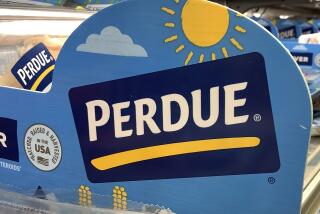These Fields of Gold Are Just Chicken Feed
- Share via
You drive down the lovely citrus-lined roads between Ventura and Santa Paula these days and you see field after field ablaze with marigolds.
Each year you forget about the marigolds. Then they crop up again all of a sudden--and, wham!--you’re transfixed by an explosion of orange that’s so extremely and awesomely orange that you have to look away. I’ve come across these stunning displays for years and they’ve always made for a quietly stirring Ventura County moment.
If I were an agricultural poet--Steve “Frost is on the Punkin” Chawkins--I’d rhapsodize about the marigolds. I’d write of their lives brief and brilliant. I’d tell about the wonders of living in a place where you can wander out for a quart of milk and an aimless drive, and end up running into outrageous beauty.
But that was until yesterday, when I found out about the growers’ real agenda for the marigolds.
Now it’s tougher to think exalted thoughts about marigolds. Shakespeare would have had trouble: “Oh that this too, too pallid flesh might resolve itself into a golden glow to draw the favorable attention of consumers to the butchered fowl in their grocers’ poultry cases. . . .”
That’s right.
The marigolds you see from the road will be thrown to the chickens, like ancient Christians to so many lions.
They might be blazing.
They might be beautiful.
But these buds, Bud, aren’t for you.
In fact, they’ll wind up with your one true love only if you happen to truly love a Rhode Island red.
This is the gritty, darker side of living around agriculture. Before you learn a little about strawberry fields, for instance, you might think they’re a gauzy and romantic concept, as in the Beatles’ “Strawberry Fields Forever.” But when you start listening to the distinctly unpoetic rants about methyl bromide and other pesticides, strawberry fields can lose their charm.
The truth about marigolds, I was astonished to learn, is that they’re the equivalent of tanning oil for chickens. Turkeys, too.
“If you put a Perdue chicken next to the others, we’re more golden,” said Tita Cherrier, a spokeswoman for Perdue, the country’s fourth-largest chicken processor.
For unknown reasons, consumers--particularly in the Northeast--have prized that golden hue since some anonymous chicken man started lacing his birds’ feed with marigolds more than 60 years ago.
“We buy thousands of tons of marigolds,” Cherrier said. “We’re known for the distinctive yellow hues of our chickens. In Russia, the name Perdue doesn’t translate well; our product there is called Golden Chicken.”
When marigold petals are crushed, the resulting essence is mixed with something called corn gluten.
Before you know it, your pullets are a fetching yellow, and you’ve mysteriously hooked another consumer with the notion, unknown to our chicken-rearing ancestors, that a yellow chicken is a better chicken.
Marigolds grow at Perdue’s headquarters in Maryland. Pictures of marigolds decorate the place. Frank Perdue himself once did a commercial about the marigold-poultry connection, but I guess I missed it.
All I know is that a rose is a rose (that’s poetry), and marigolds are chicken feed (that’s not).
*
Steve Chawkins can be reached at 653-7561 or at steve.chawkins@latimes.com.
More to Read
Eat your way across L.A.
Get our weekly Tasting Notes newsletter for reviews, news and more.
You may occasionally receive promotional content from the Los Angeles Times.










